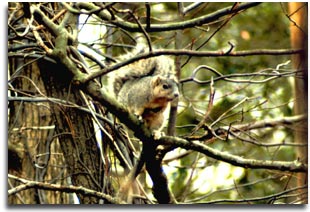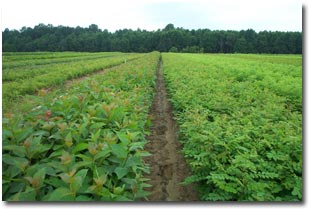The Expansion of the Forestry Profession in Maryland
Steven W. Koehn, MD State Forester
 In a way, the expansion of the forestry profession is a result of the expansion of the public’s values and expectations as they relate to the forest. But the environmental movement that spawned a host of conservation measures in the second half of the 20th century - like the federal Clean Water Act and Endangered Species Act and, in Maryland, the landmark creation of the Forest Conservancy District Boards and Statement of the
Conservation Policy of the State - shifted the focus to an even wider range of
values from forests. It is no longer enough just to provide wood products for
the economy in a sustainable manner. It also is necessary to ensure that water
and air quality meet certain standards, that forest management practices protect
habitat for fish and other species that depend on forest streams, that they
protect habitat for an abundant and diverse wildlife population and that they
provide for the recreation and spiritual nourishment of the public.
In a way, the expansion of the forestry profession is a result of the expansion of the public’s values and expectations as they relate to the forest. But the environmental movement that spawned a host of conservation measures in the second half of the 20th century - like the federal Clean Water Act and Endangered Species Act and, in Maryland, the landmark creation of the Forest Conservancy District Boards and Statement of the
Conservation Policy of the State - shifted the focus to an even wider range of
values from forests. It is no longer enough just to provide wood products for
the economy in a sustainable manner. It also is necessary to ensure that water
and air quality meet certain standards, that forest management practices protect
habitat for fish and other species that depend on forest streams, that they
protect habitat for an abundant and diverse wildlife population and that they
provide for the recreation and spiritual nourishment of the public.
The expansion of the forestry profession can be likened to a widening path.
In this metaphor, there was no forestry at all as we began to take wood from our
forests. We just cut trees for fuel and construction, cleared land for farming
and urban development, and gave no thought to managing forests for the future.
At that point, the path was narrow. As society’s expectations grew and expanded,
the pathway widened. Professional foresters changed their management methods and
priorities to respond to a wider range of uses and values. This expansion of
forest values has in turn demanded more of forest managers and expanded the
forestry profession to include entirely new disciplines. For example, foresters
have learned from fisheries biologists about protecting aquatic habitat and have
responded by finding ways to construct and maintain roads to eliminate or
minimize runoff and erosion that might deposit sediment in streams and degrade
spawning beds. Forest hydrologists, who have expertise in matters pertaining to
the quality and quantity of surface and ground water in forests, provide
guidance on the installation of both culverts and bridges that have minimal
Fire in our forest has been studied extensively and to a large extent
suppressed over the past century. Many foresters today have extensive
responsibility for fire fighting and post-fire restoration - ensuring the health
of new forest growth until it is free to grow without risk of being overtaken by
competing vegetation.
Wildlife biologists are now partners with forest managers, providing
information to help them design harvest prescriptions that will promote species
diversity and abundance. As foresters learn about habitat needs from wildlife
biologists, they often can be proactive in protection by creating tree structure
and species mixes that will result in desirable habitat for specific wildlife
species.
The profession also has expanded as a result of technical advances. The
development of laser scanning technology has enabled mill operators to position
logs precisely for the most efficient cuts as they move through the saws.
Although waste wood fiber from sawmills has long been turned into useful
products like paper or composite wood products (particleboard, hardboard,
medium-density fiberboard, etc.), wood chemists are constantly expanding the
possibilities by re-searching and developing new adhesives, preservatives and
other chemical-based products used in wood products manufacturing.
It did not take long for forest managers to realize the potential application
of satellite technology for long-term resource management planning. Today, foresters can analyze tree age and species mix over large areas of landscape from satellite imagery and can plan effective harvests accordingly. Computer technology has enabled planners to develop sophisticated modeling programs that will show them what a forest might look like in 20, 50, 100 or even 200 years as a result of specific actions undertaken today. Creating a forest landscape with stands of varied ages and classes benefits wildlife diversity, and foresters today use technology in achieving that goal. As a result of the growing use of technology in forest management, the field of forestry consulting has grown as well. Many landowners now hire consultants not only for their knowledge, but also for their access to and use of high-tech tools and equipment in making management recommendations.
 Even the traditional field of silviculture has grown. In the area of reforestation, for example, foresters now determine the ideal species mix to target when regenerating a harvested forest, and nursery managers provide seedlings from the best nearby seed sources to help ensure that they will flourish. The Maryland Pine Tree Reforestation Law requires successful reforestation. In Maryland alone, foresters oversee the planting of more than 5 million seedlings every year, and reforestation success now approaches 100
percent.
Even the traditional field of silviculture has grown. In the area of reforestation, for example, foresters now determine the ideal species mix to target when regenerating a harvested forest, and nursery managers provide seedlings from the best nearby seed sources to help ensure that they will flourish. The Maryland Pine Tree Reforestation Law requires successful reforestation. In Maryland alone, foresters oversee the planting of more than 5 million seedlings every year, and reforestation success now approaches 100
percent.
The expansion of values the public demands of the state’s forests continues
to widen the path and in turn increase the number of disciplines the forestry
profession embraces. Many of these are in public. In Maryland, the Department of
Natural Resources’ Forest Service employs experts in multiple disciplines who
work in resource analysis and policy formulation as well as public forestland
management, private forest landowner assistance, urban forestry and many others.
Of course, as forestry has grown as an industry, economics has played a
larger and larger role. Bringing sophisticated economic modeling practices,
portfolio strategies and marketing techniques to bear on the forest industry has
created many opportunities for those interested in the business side of the
profession. Maryland’s forest product industry is larger than the seafood
industry, employing over 14,000 people and adding over $2.2 billion to
Maryland’s overall economy. The forest product industry is the largest industry
in Western Maryland and the second largest industry behind poultry on the
Eastern Shore.
Forestry in the Future
Many changes have occurred since forestry became a professional field over a
century ago. The profession has expanded with the development of new forest
products, the internationalization of the industry and its markets, the
resultant expansion of fields related to policy and economics, and the many new
careers related to forest recreation. The foresters of a century ago have been
joined by forest ecologists, hydrologists, wildlife biologists, watershed
experts, urban foresters, marketing managers and policy analysts, to name just a
few. New minds and new skills continue to bring new expertise to a dynamic
profession working to keep forests sustainable and productive and to fill the
needs of society for the many products that come from trees.